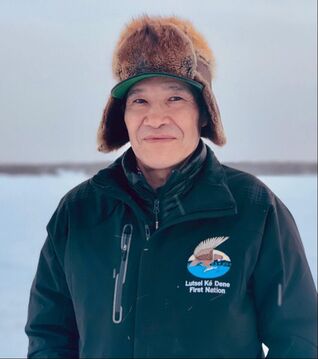Ɂedacho Kué – The Caribou Season
Herman Gahdële

|
On the south east side of Ɂedacho Kué near K’ıchı Nué (Crystal Island), there are rocks piled about four feet high in the shape of an S and a U. With the S-rock you can jump on one side or jump on the other side, depending where the caribou are. The people hide between them and use bow and arrow to harvest ɂetthën.
People don’t hunt by themselves. They work as a pack because it’s hard to hunt. The fast runners chase the caribou towards the arrow man. Everybody knows what to do. Everybody depends on each other. One mistake and they all get hungry. |
|
The people know when ɂetthën are coming. The elders know ahead of time if they will be earlier or later that year. They make sure they are there at the right time. They don’t have radar, but they know. There are other things that tell them, things like flies and ravens and seasonal changes. This is knowledge that is gathered over time. It goes a long way back, from when the people first tasted caribou.
In the springtime, ɂetthën return to the tundra. We say, nah-us. They are turning, they are heading back. |
|
In the old days, when people gathered twice a year to harvest together, they would also have great activities including drum dancing, hand games, Dene trade, and competitions.
There were hundreds, maybe even thousands of people here. People from four different directions and nations: Łutsël K’é, Yellowknife, Behchokǫ̀, and Deninu Kųę́. There were teepees a long way down the shore on both sides of the esker. My Granny said that it was just noisy. The gatherings happened at the two caribou crossings: Desnetche (fall time) and Gaspa Kué Des (spring time). |
|
The competitions happen after the harvest, when there is lots of meat. My grandfather and others have big bundles of dry meat and fat, the meat made by their wives, mothers, aunties. They take the bundles way out. People line up on both sides of the esker to watch the competition. Using a bow and arrow, you get one shot to try and reach the bundles. If your arrow wobbles while it’s flying, people laugh. But if it travels smooth and straight, they know there is a good person behind that arrow. They say, That guy knows what he’s doing. The closest arrow to the dry meat takes it all home.
|
|
When the people hear the first thunder on the esker at Gaspa Kué Des, the whole nation yells. They put their arms up with fists clenching strongly and with their whole heart they yell, “Marsi choooo!” It means I made it through the cold winter with my family. Some cry because not everyone made it. They grieve for those who were lost. The yell means I’m happy I made it here today.
Thank you. |
|
Ni Hat’ni Dene, the Indigenous guardians of Thaidene Nëné, and community members have observed that ɂetthën rarely pass by Ɂedacho Tué now, just as they no longer come to Łutsël K’é. Even though the caribou haven’t been coming to Ɂedacho Tué lately, the lake remains an important stop on winter journeys to other places in hazúghe (barrenlands), and visits by community members to the Łutsël K’é Dene First Nation’s cabin at Ɂedacho Tłaze are common year-round.
|
CONNECT |
VISIONWe are the Lutsel K’e Dene First Nation. Our vision for Thaidene Nëné is:
Nuwe néné, nuwe ch'anıé yunedhé xa (Our land, our culture for the future). We’re working with our partners to permanently protect Thaidene Nëné—part of our huge and bountiful homeland around and beyond the East Arm of Tu Nedhé. |
